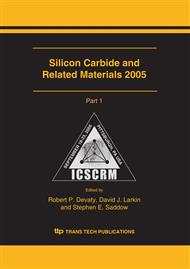[1]
G. Y. Chung, C. C. Tin, J. R. Williams, K. McDonald, M. Di Ventra, S. T. Pantelides, L. C. Feldman and R. A. Weller: Applied Physics Letters, 76, (2000), p.1713.
Google Scholar
[2]
G. Chung, C. C. Tin, J. R. Williams, K. McDonald, M. Di Ventra, R. K. Chanana, S. T. Pantelides, L. C. Feldman and R. A. Weller: Applied Physics Letters, 77, (2000), p.3601.
DOI: 10.1063/1.1318229
Google Scholar
[3]
H. -F. Li, S. Dimitrijev, H. B. Harrison and D. Sweatman: Applied Physics Letters, 70, (1997), p. (2028).
Google Scholar
[4]
L. A. Lipkin, M. K. Das and J. W. Palmour: Materials Science Forum, 389-393, (2002), p.985.
Google Scholar
[5]
R. Schörner, P. Friedrichs, D. Peters and D. Stephani: IEEE Electron Device Letters, 20, (1999), p.241.
Google Scholar
[6]
I. C. Vickridge, I. Trimaille, J. -J. Ganem, S. Rigo, C. Radtke, I. J. R. Baumvol and F. C. Stedile: Physical Review Letters, 89, (2002), p.256102.
DOI: 10.1103/physrevlett.89.256102
Google Scholar
[7]
Y. Song, S. Dhar, L. C. Feldman, G. Chung and J. R. Williams: Journal of Applied Physics, 95, (2004), p.4953.
Google Scholar
[8]
V. V. Afanasev, M. Bassler, G. Pensl and M. Schulz: Physica Status Solidi A, 162, (1997), p.321.
DOI: 10.1002/1521-396x(199707)162:1<321::aid-pssa321>3.0.co;2-f
Google Scholar
[9]
K. Fukuda, W. J. Cho, K. Arai, S. Suzuki, J. Senzaki and T. Tanaka: Applied Physics Letters, 77, (2000), p.866.
Google Scholar
[10]
S. Dhar, L. C. Feldman, S. Wang, T. Isaacs-Smith and J. R. Williams: Journal of Applied Physics, 98, (2005), p.14902.
Google Scholar
[11]
W. Lu, L. C. Feldman, Y. Song, S. Dhar, W. E. Collins, W. C. Mitchel and J. R. Williams: Applied Physics Letters, 85, (2004), p.3495.
Google Scholar
[12]
K. -C. Chang, Y. Cao, L. M. Porter, J. Bentley, S. Dhar, L. C. Feldman and J. R. Williams: Journal of Applied Physics, 97, (2005), p.1.
Google Scholar
[13]
C. Virojanadara and L. I. Johansson: Journal of Physics Condensed Matter, 16, (2004), p.1783.
Google Scholar
[14]
J. B. Casady and R. W. Johnson: Solid-State Electronics, 39, (1996), p.1409.
Google Scholar
[15]
K. McDonald, R. A. Weller, S. T. Pantelides, L. C. Feldman, G. Y. Chung, C. C. Tin and J. R. Williams: Journal of Applied Physics, 93, (2003), p.2719.
Google Scholar
[16]
S. Dhar, L. C. Feldman, K. -C. Chang, Y. Cao, L. M. Porter, J. Bentley and J. R. Williams: Journal of Applied Physics, 97, (2005), p.1.
Google Scholar
[17]
S. Dhar, Ph.D. dissertation, Vanderbilt University, (2005).
Google Scholar
[18]
K. Fukuda, S. Suzuki, T. Tanaka and K. Arai: Applied Physics Letters, 76, (2000), p.1585.
Google Scholar
[19]
J. Senzaki, K. Fukuda, K. Kojima, S. Harada, R. Kosugi, S. Suzuki, T. Suzuki and K. Arai: Materials Science Forum, 389-393, (2002), p.1061.
DOI: 10.4028/www.scientific.net/msf.389-393.1061
Google Scholar


